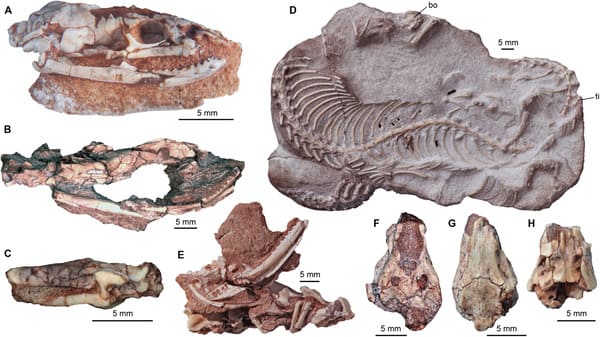Considering how diverse snakes are today (nearly 500 genera, about 3,000 named species), we still know very little about their ultimate origins. Apparently, these cold-blooded, slithering, legless creatures evolved from four-legged reptilian ancestors that were either small, cave-dwelling, land-based lizards (the popular theory) or emerged in the oceans surrounding Earth 100 million years ago The marine reptile family Mosasaurus evolved from.

Mosasaurus fossil, an extinct mosasaur - photo taken at the Natural History Museum Maastricht
1. Piecing together the evolution of snakes
Why is the evolution of snakes an eternal mystery? A big part of the problem is that the vast majority of snakes are small, relatively fragile creatures, and their even smaller, more fragile ancestors are represented in the fossil record as incomplete remains, consisting mostly of scattered vertebrae. Paleontologists have discovered putative snake fossils dating back 150 million years, to the late Jurassic period, but the traces are so fleeting they're virtually useless. (To complicate matters further, snake-like amphibians known as "astopods" appear in the fossil record more than 300 million years ago, most notably in the genus Ophiderpeton; they are completely unrelated to modern snakes.) However, Conclusive fossil evidence has recently emerged: Eophis, a 3-meter-long Middle Jurassic snake native to Britain.

2. Snakes in the Early Cretaceous
Needless to say, a key event in snake evolution was the progressive withering of these reptiles' forelimbs and hindlimbs. Creationists like to claim that no such "transitional forms" exist in the fossil record, but as far as prehistoric snakes are concerned, they're completely wrong: paleontologists have identified no fewer than four different genera whose origins date back By the Cretaceous period, they were equipped with stubby, vestigial hind legs. Curiously, three of the snakes—Eupodophis, Haasiophis, and Pachyrhachis—are found in the Middle East, not a hotbed of fossil activity, while a fourth snake, the Najash, lives on the other side of the world, in South America. .

What secrets do these two-legged ancestors reveal about snake evolution? Well, the answer is complicated because the Middle Eastern genera were discovered first—and, because they were found in geological formations that were submerged in water 100 million years ago, paleontologists take this as evidence that snakes evolved as a whole From an aquatic reptile, most likely the sleek, ferocious mosasaur of the late Cretaceous period. Unfortunately, the Najash people of South America cast doubt on this theory: the two-legged snake was clearly a terrestrial snake, and appears in the fossil record around the same time as its Middle Eastern cousin.

Today, the prevailing view is that snakes evolved from an as-yet-unidentified land lizard (possibly a burrowing lizard) in the Early Cretaceous, most likely a type of lizard known as a "varanid." Today, the monitor family is represented by monitor lizards (genus Monitor), the largest living lizards on Earth. Oddly, the prehistoric snake may have been a cousin of the giant prehistoric monitor lizard, which was about 7.5 meters long from head to tail and weighed over two tons!

3. Prehistoric giant snakes of the Cenozoic Era
Speaking of giant monitors, some prehistoric snakes also reached gigantic sizes, although the fossil evidence is again frustratingly inconclusive. Until recently, the largest prehistoric snake in the fossil record was aptly named Gigantophis, a late Eocene monster that was about 10 meters long from head to tail and weighed half a ton. Technically, Gigantophis is classified as a "madtsoiid" snake, meaning it is closely related to the widespread genus Madtsoia.

Unfortunately for fans of giant snakes, this prehistoric snake's place in the record has been overshadowed by a larger genus with a cooler name: the South American Titanoboa, which grew to over 15 meters long and weighed perhaps To the tune of a ton. Oddly enough, Titanoboa dates back to the mid-Paleocene epoch, about five million years after the extinction of the dinosaurs but millions of years before mammals evolved to giant size. The only logical conclusion is that the prehistoric snake preyed on an equally huge prehistoric crocodile, a scenario you could see computer simulated in a future TV special; it might also occasionally have had an encounter with the equally giant prehistoric tortoise Carbonemys over contact.

animal tags:
We created this article in conjunction with AI technology, then made sure it was fact-checked and edited by a Animals Top editor.